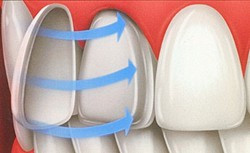Dental veneers (sometimes called porcelain veneers or dental porcelain laminates) are wafer-thin, custom-made shells of tooth-colored materials. They are designed to cover the front surface of teeth to improve your appearance. These shells are bonded to the front of the teeth changing their color, shape, size, or length.
Dental veneers can be made from porcelain or from resin composite materials. Porcelain veneers resist stains better than resin veneers and better mimic the light reflecting properties of natural teeth. Resin veneers are thinner and require removal of less of the tooth surface before placement. Getting a dental veneer usually requires three trips to the dentist. One for a consultation and two to make and apply the veneers.
Dental Veneers, Diagnosis and treatment planning.
Your dentist will examine your teeth to make sure dental veneers are appropriate for you and discuss what the procedure will involve and some of its limitations. He or she also may take X-Rays and possibly make impressions of your mouth and teeth.
To prepare a tooth for a veneer, your dentist will remove about 1/2 millimeter of enamel from the tooth surface, which is an amount nearly equal to the thickness of the veneer to be added to the tooth surface. Before trimming off the enamel, you and your dentist will decide the need for a local anesthetic to numb the area. Next, your dentist will make a model or impression of your tooth. This model is sent out to a dental laboratory, which in turn constructs your veneer. It usually takes 1-2 weeks for your dentist to receive the veneers back from the laboratory.
To reduce the risk of damage to your veneers, do not bite or chew on hard objects such as nut shells or bones. Also, do not use your teeth to open or tear packages. Your dentist also may advise you to avoid certain foods that could damage the porcelain or composite used.
Brush and floss your teeth as you normally would, and be sure to use a non-abrasive toothpaste. Because veneers are able to be highly polished, the risk of staining the veneers with food or drink after the procedure is complete is greatly reduced. However, brushing after drinking red wine, coffee, tea or soda is advisable. Here are some other cosmetic dentistry tips.



